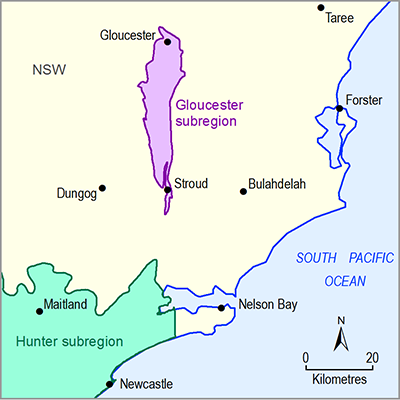The total number of ecological assets in the preliminary assessment extent (PAE) of the Gloucester subregion is 116 (made up from 3400 elements). They fall within five of the ten ecological asset classes (Table 10): ‘River or stream reach, tributary, anabranch or bend’, ‘Wetland, wetland complex or swamp’, ‘Aquifer, geological feature, alluvium or stratum’, ‘Groundwater‑dependent ecosystems’ and ‘Habitat (potential species distribution)’. As described in the companion submethodology M02 (as listed in Table 1) for identifying water‑dependent assets (Mount et al., 2014), an asset may be made up of one or many polygons termed ‘elements’, and the number of elements for each asset is indicated in the following tables.
Table 10 Classification of elements into ecological assets in the preliminary assessment extent (PAE) of the Gloucester subregion
Landscape features such as aquifers, rivers and wetlands are obviously water dependent and are included in the water‑dependent asset register (Table 11 to Table 13). The distribution of these is shown in Figure 7. As described in Section 1.3.3.2 below, data from the Atlas of Groundwater Dependent Ecosystems (Bureau of Meteorology, 2012) were not ‘fit for purpose’ for the bioregional assessment of the Gloucester subregion and have not been included in the water‑dependent asset register (Table 14). However, more accurate mapping of groundwater‑dependent ecosystems (GDEs) obtained from the NSW Office of Water will be used in the assessment to identify receptors for GDEs.
Table 11 Assets within the ‘Aquifer geological feature, alluvium or stratum’ class
|
Asset namea |
Elements |
In register |
|---|---|---|
|
Hunter‑Central Rivers Karuah Alluvium |
1 |
Yes |
|
Hunter‑Central Rivers Manning Alluvium |
1 |
Yes |
|
Hunter‑Central Rivers New England Fold Belt |
1 |
Yes |
aPunctuation and typography appear as used in the asset database.
Table 12 Assets within the ‘River or stream reach, tributary, anabranch or bend’ class
|
Asset namea |
Elements |
In register |
|---|---|---|
|
Catchments 237, 243–247, 250–256, 298, 300, 308, 329–330, 344, 347, 356–357, 464 |
24 |
Yes |
|
Hunter‑Central Rivers Karuah River Estuary |
1 |
Yes |
aPunctuation and typography appear as used in the asset database.
Table 13 Assets within the ‘Wetland wetland complex or swamp’ class
|
Asset namea |
Elements |
In register |
|---|---|---|
|
Port Stephens Estuary |
140 |
Yes |
aPunctuation and typography appear as used in the asset database.
Table 14 Assets within the ‘Groundwater‑dependent ecosystems’ class
aPunctuation and typography appear as used in the asset database.
Thirty‑six of the 43 ecological assets that were classified as ‘Habitat (potential species distribution)’ were included in the water‑dependent asset register on the basis that they were judged to be moderately or highly water dependent (Table 15). These included the Karuah National Park and the threatened ecological community ‘Lowland Subtropical Rainforest on Basalt Alluvium in NE NSW and SE Qld’ (Figure 7), as well as fish biodiversity hotspots and the oyster growing areas within the Karuah River. The justification for judging seven of the assets as having low water dependence, and excluding them from the water‑dependent asset register, is provided in Table 16.
Table 15 Assets within the ‘Habitat (potential species distribution)’ class
Although examples of individual species are listed below, bioregional assessments consider the potential impact to the habitat of species not individual species per se.
aPunctuation and typography appear as used in the asset database.
Table 16 Justification for judgement of low water dependence for seven assets
(a) Groundwater assets, (b) Surface water assets and (c) Vegetation and wetland assets


